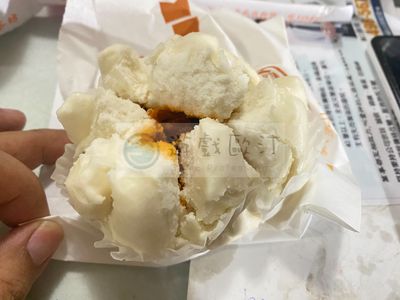廣東點心的經典:叉燒包
叉燒包是廣東點心中的經典,深受華人社群乃至全球各地食客的喜愛。叉燒包通常出現在茶樓的點心推車中,是早茶不可或缺的一部分。叉燒包的內餡主要是甜鹹適中的叉燒(燒烤過的豬肉),與特製醬料混合包裹在軟嫩的麵團中,蒸熟後外皮鬆軟、內餡鮮美,入口即化。
是將叉燒肉(中國風味的燒烤豬肉)作為主要餡料的包子。它的發源地是廣東,並且在飲茶文化中有著舉足輕重的地位。外觀上呈圓形,麵皮通常白皙、鬆軟,蒸熟後表皮會自然裂開,露出部分內餡,這是叉燒包的經典特色之一。這種天然裂開的表面被稱為「開口笑」,也是叉燒包在視覺上吸引人的一個元素。
叉燒包分為兩種主要類型:蒸叉燒包和烤叉燒包。蒸叉燒包是最常見的形式,表皮柔軟白嫩;而烤叉燒包(又稱「酥皮叉燒包」)的外皮則較為酥脆,帶有金黃色澤。這兩種做法各有擁躉,並且風味略有不同。製作叉燒包的過程分為兩個主要步驟:準備內餡和製作麵皮。
1.叉燒內餡的製作:叉燒是叉燒包的靈魂。通常,製作叉燒需要先將豬肉(多為豬肩肉或五花肉)以蜂蜜、醬油、蠔油、糖和五香粉等調味料醃製,然後放入烤箱或燒烤架上以高溫烘烤,使其外層呈現焦糖色澤並帶有獨特的焦香味。烤好的叉燒切成小塊,並與特製的叉燒醬拌勻。叉燒醬通常由生抽、糖、蠔油、紹興酒等混合製成,帶有微甜的鹹香味道,使得叉燒內餡更加濃郁可口。內餡必須保持適當的粘稠度,以便包製時不會外溢。
2.麵皮的製作:麵皮的製作是叉燒包的關鍵。傳統的叉燒包麵皮使用的是發酵麵團,這樣在蒸製過程中可以形成鬆軟且帶有些許彈性的口感。製作過程通常包括將麵粉、糖、酵母和水混合,然後經過發酵,直到麵團膨脹、柔軟。這個發酵過程需要掌握好時間,過長或過短都會影響最終的口感。發酵完成後,麵團會被分割成均勻的小塊,並壓平成小圓片,準備包餡。
3.包製與蒸製:叉燒內餡放入麵皮中,將麵皮收口包成包子形狀。通常這個過程需要快速且技巧熟練,以確保麵皮均勻包裹內餡,並保持光滑圓潤的外形。包好後的叉燒包放入蒸籠中,以中高火蒸約10至15分鐘,直到麵皮膨脹,並且表面開裂,露出內餡的部分色澤。這是蒸叉燒包的標誌性特徵。
烤叉燒包的製作則稍有不同,它的麵皮中會添加油脂,使外層在烘烤時形成酥脆的口感。烤叉燒包的包製完成後,會被送入烤箱,而非蒸籠,烤至金黃酥脆。
叉燒包的製作看似簡單,但每一個步驟都至關重要,尤其是麵皮的發酵與內餡的調味,需要恰到好處才能達到完美的口感。
叉燒包作為中國點心的代表,將燒烤過的叉燒與柔軟的包子皮巧妙結合,創造出甜鹹交融、口感層次豐富的美味。蒸叉燒包的鬆軟細膩和內餡的濃郁味道,使其成為茶樓飲茶時的熱門選擇。而烤叉燒包則以其酥脆的外皮,提供不同的味覺體驗。無論是哪一種版本,都展現粵菜中的工藝與創意,並且在全球美食界占據一席之地。
Char Siu Bao (Chinese BBQ Pork Buns) is a classic Cantonese dim sum dish, beloved by the Chinese community and food enthusiasts worldwide. Typically found on dim sum trolleys in tea houses, char siu bao is an essential part of the traditional Cantonese breakfast known as yum cha. The filling consists primarily of sweet and savory char siu (barbecued pork), mixed with a special sauce and wrapped in soft dough. When steamed, the bun's outer layer becomes fluffy, while the filling remains juicy and flavorful, melting in your mouth.
Char siu bao features barbecued pork as the main filling. Originating from Guangdong, it holds a significant place in dim sum culture. Visually, the buns are round with a soft, white dough. When steamed, the exterior naturally cracks open, revealing part of the filling inside, a signature characteristic of char siu bao. This cracked surface, often called "smiling mouth," adds to the visual appeal of the bun.
There are two main types of char siu bao: steamed and baked. The steamed version is the most common, with a soft, white exterior, while the baked version (also known as "crispy skin char siu bao") has a golden, crispy crust. Both versions have their loyal fan base, with slight differences in taste and texture. The preparation of char siu bao involves two major steps: preparing the filling and making the dough.
Making the char siu filling: The char siu, or barbecued pork, is the heart of the dish. Typically, the pork (usually pork shoulder or pork belly) is marinated in a mixture of honey, soy sauce, oyster sauce, sugar, and five-spice powder, then roasted in an oven or over a grill until the exterior caramelizes, giving it a unique smoky flavor. After roasting, the char siu is chopped into small pieces and mixed with a specially made char siu sauce, which is often a combination of soy sauce, sugar, oyster sauce, and Shaoxing wine, creating a sweet-savory glaze. The filling should have a slightly sticky texture to prevent spilling during the bun-making process.
Making the dough: The dough is key to the bun's soft texture. Traditional char siu bao dough uses a yeast-leavened dough, which gives the buns their signature fluffy and elastic texture. The process involves mixing flour, sugar, yeast, and water, then allowing the dough to ferment until it becomes soft and rises. This fermentation step is crucial, as the timing affects the final texture of the buns. Once fermented, the dough is divided into small portions and rolled into flat discs, ready for the filling.
Assembling and steaming: The char siu filling is placed in the center of the dough, which is then wrapped and sealed into a bun shape. This step requires speed and precision to ensure that the dough evenly encloses the filling and maintains a smooth, round shape. After assembly, the buns are placed in a steamer and steamed over medium-high heat for about 10 to 15 minutes, during which the dough expands and cracks open, revealing the vibrant filling inside—a hallmark of a well-made steamed char siu bao.
For the baked version, the dough typically contains additional fat to create a crispy outer layer. Instead of being steamed, these buns are baked until golden brown and crispy.
Making char siu bao might seem simple, but each step is critical, especially in the fermentation of the dough and the seasoning of the filling, to achieve the perfect balance of texture and flavor.
As a quintessential Chinese dim sum item, char siu bao masterfully combines the rich, roasted flavors of char siu with the tender, fluffy bun dough, creating a sweet and savory experience with complex textures. The steamed version offers a soft and delicate bite with a rich filling, making it a popular choice for yum cha, while the baked version presents a different culinary experience with its crispy crust. Both versions showcase the artistry and creativity of Cantonese cuisine and have earned their place in the global culinary landscape.

- 1
- 2
- 3
- 4
